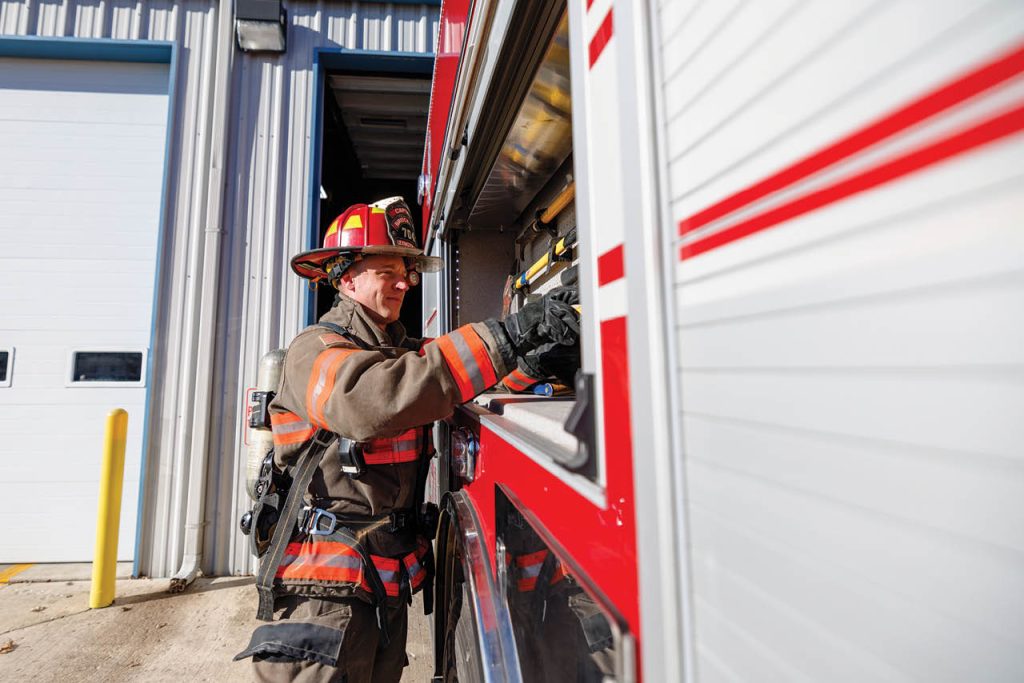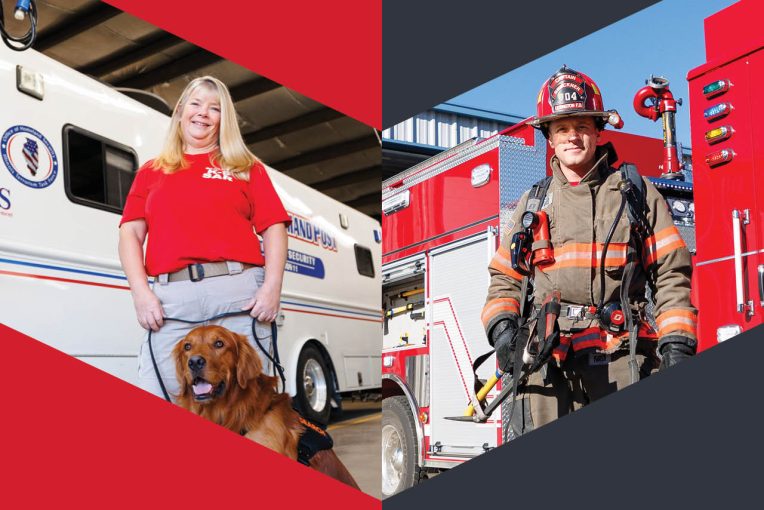When Dr. Joan Brehm, chair and professor in the Department of Sociology and Anthropology at Illinois State University, first learned that the puppy she adopted during graduate school had all the right markers of a search and rescue animal, she didn’t think she would become a K9 handler herself. Now, 26 years later, she’s still doing that important work.
“I sort of stumbled into this almost by accident, but now it’s something that I can’t imagine not doing anymore,” Brehm said.
Brehm’s first dog, “Chief,” was trained for avalanche rescue, wilderness area search, and human remains detection. Over the years, she has volunteered with nonprofit organizations such as Illinois Search Dogs and is now with the McLean County Emergency Management Agency, which coordinates teams trained and certified for disaster responses. In 2011, when an EF-5 tornado struck Joplin, Missouri, Brehm’s team was called within hours by the State Office of Emergency Management in Missouri.
“It was unlike anything I’ve ever seen,” she said. “The tornado wiped everything off the face of the Earth, and it just looked like a moonscape. We had to methodically search all the debris because so many people were unaccounted for. It’s amazing that more people did not lose their lives.”
Brehm said she was stunned by the resilience of the community, even in that dire scenario. People would come up to share food, water, and to make sure the teams were doing OK.
“It’s hard to put into words until you experience it,” she said.
Brehm and her K9s have provided search and rescue in the aftermath of tornadoes in and out of the state, assisted with smaller incidents in the Bloomington-Normal area, and even aided a search and rescue mission in Costa Rica. She is now training her fifth dog, “Rip,” to become a certified K9 for disaster response.
“I’m a firm believer in giving back to the communities where we live, and this is my way of giving back,” she said.
For Brehm and other faculty and staff members, the University’s policies and procedures have a section on Disaster Service Volunteer Leave, which grants employees leave with pay for up to 20 workdays in a 12-month period to assist in disasters when certain conditions are met (Policy 3.1.11).
—Joan Brehm
“I’m a firm believer in giving back to the communities where we live, and this is my way of giving back.”
“We want people to know that these benefits are in place,” said Kelly Walker, director of benefit services in Human Resources at Illinois State. “And if there are other criteria that could be applied, we are happy to take it under consideration when reviewing policies.”
Another new benefit that began in 2024 is Personal Plus Time, which can be used to support eligible faculty and staff who want to pursue activities like civic engagement, volunteering, and other opportunities that are important to employees’ well-being and service to the community.
In addition, also starting in 2024, a new policy was implemented to accommodate employees participating in eligible firefighter training and certifications.
Ian Bruckner, project manager and portfolio coordinator of digital transformation and process improvement in the Office of Technology Solutions, was looking for a way to give back to the community when he joined the fire service where he lives in Lexington, as a volunteer firefighter. He recalls that when his son was delivered early, he had to be seen by doctors and emergency medical technicians (EMTs) who were often paged late at night and lost sleep to help others.
“That inspired me, and that was when I decided I needed to do something,” Bruckner said.
Since becoming a volunteer firefighter in 2015, Bruckner has responded to multiple incidents. His fire department is part of the Mutual Aid Box Alarm System (MABAS), a pioneer system in Illinois where formalized dispatch centers connect fire departments ready to step in and assist communities whenever necessary.
Besides fire incidents such as a 2023 Lasalle/Carus chemical plant fire, Bruckner has responded as an EMT to other disaster-relief scenarios, like the EF-2 tornado that struck Pontiac in 2016. During the COVID-19 pandemic, he also joined the Medical Reserve Corp with the McLean County Health Department. Bruckner currently serves as a captain with the Lexington Fire Protection District. He also takes on grant writing for the district, plans operations, and acts as a public information officer.
“Rather than just doing firefighting and EMS, there is a little bit of training and managing now,” he said.
Bruckner’s defining moment in his volunteering journey came while he was in EMT training.

“I arrived at an accident site where a wrong-way driver collided on the interstate with a family traveling in a brand-new van,” he said. “I pulled a child out of the vehicle who was about six months older than my son was at that time, and he was wearing the same kind of pajamas that my son would have been wearing. He was missing an arm, and I just held him and stopped the bleeding until the ambulance came, and we took him to the hospital where a helicopter picked him up. He survived. The whole family survived. Their lives were changed.”
Bruckner later got the chance to meet up with the family at a rehabilitation center in Chicago around Christmastime.
“I got to give that 4-year-old kid my probationary fire helmet as something he could keep,” Bruckner said. “Accidents happen, and with my training, I can help them hopefully get out of it in a way that’s as close to their normal life as possible. People once gave that sort of service to my family, and that’s why I had to turn around and give it to others.”
Reflecting on her volunteer experience, Brehm said it’s a very different world from her academic world, but she finds the two complementary. She believes her experience being a K9 handler enhanced her commitment to civic engagement and community service.
“It doesn’t matter how we do it, but it matters that we do it,” Brehm said. “Because when we’re connected to our community, we have a greater sense of compassion, support, and empathy for each other. It allows us to understand our differences in a way that is beneficial instead of harmful. We start seeing those differences as a value and not something to be feared or dismissed.”

